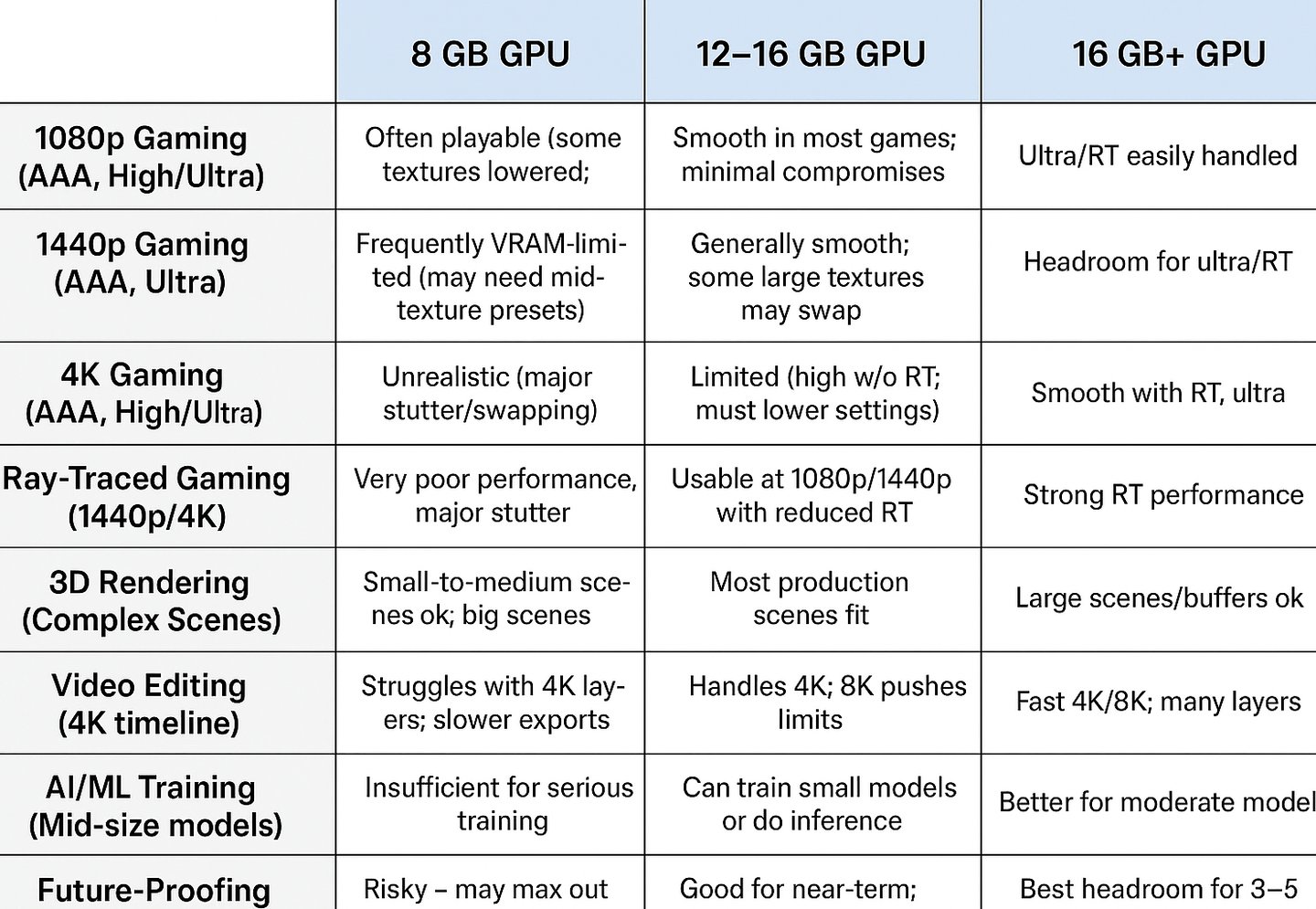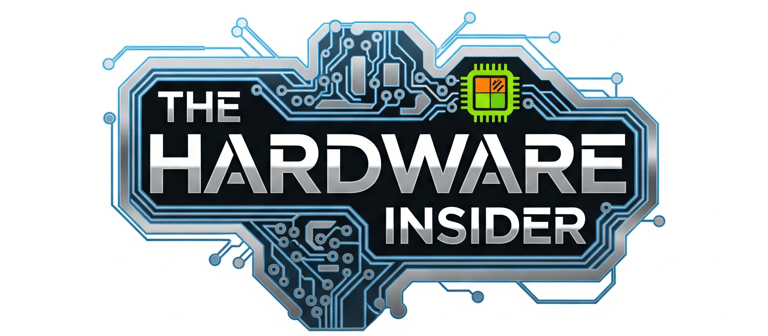8GB Graphics Cards in 2025: Why They’re Becoming Obsolete
Is 8GB VRAM enough in 2025? Discover why 8GB graphics cards are becoming outdated for gaming, video editing, and 3D rendering — and why upgrading to 12GB or 16GB GPUs is the smarter, future-proof choice.
PC HARDWARE GUIDE
Tayyab
10/3/20255 min read
Modern games and applications are aggressively pushing video RAM (VRAM) well past 8GB. High-end AAA games at 1440p or 4K – especially with ultra–high-resolution textures and ray tracing enabled – routinely demand 12–20 GB of GPU memory. According to recent tests, many titles can’t maintain 30 FPS at max settings on cards below 12 GB VRAM. Creative workloads paint a similar picture: 3D rendering, 4K/8K video editing, and AI tools often rely on 12–24 GB or more to store complex scenes and data. In practice, an 8 GB card still runs games at low/mid settings, but it must constantly offload assets to slower system RAM, causing stutter, texture pop-in, and lower 1%-FPS. By contrast, 12 GB or 16 GB cards handle high textures and ray-tracing much more smoothly. As one hardware review put it, 12 GB is now a “practical floor” for new games at 1080/1440p, and 16 GB+ is the safer bet.
AAA Gaming: 1440p/4K Textures and Ray Tracing
AAA titles are shipping with ever-larger texture pools and mandatory ray tracing, which eat up VRAM fast. Experts now recommend 12 GB as the minimum for high settings in modern games, and 16 GB for ultra settings or 1440p gaming. For example, Indiana Jones and the Great Circle (Dec 2024) uses “Hyper” texture presets that lock in a massive texture pool. Digital Trends reports that any GPU with less than 12 GB of VRAM “couldn’t even maintain 30 fps” at max settings in that game. In that test, a cheap Intel Arc A770 (16 GB) outperformed an RTX 3080 (10 GB) simply due to having more memory. Similarly, tests show that dropping below 8 GB leads to serious frame spikes and game hitches, even at 1080p.
Upscaling technologies like DLSS or FSR do not reduce texture VRAM requirements. They render at lower resolution but still load high-res textures into memory. In practice, a gamer with an 8 GB card must crank down texture/detail settings or disable ray-tracing to avoid running out of VRAM – whereas a 12–16 GB card can keep high-quality assets resident. TechGuided summarizes it succinctly: “For 1440p, 16 GB is the sweet spot in modern AAA; for 4K or heavy ray tracing, 16–24 GB is where you want to be”. In short, 8 GB GPUs can still play older or indie games, but new blockbuster PC games in 2025 expect more memory headroom.
Professional Workloads: 3D Rendering, Video Editing, and AI
Creative software also benefits from extra VRAM. 3D artists working in Blender, Maya or Unreal Engine often use large texture sets and scenes, and more GPU memory means bigger scenes fit without slowdown. Likewise, video editors pulling 4K/8K footage (especially RAW or multi-cam timelines) need large VRAM to keep previews smooth. For example, benchmarks show the RTX 4070 Ti Super (16 GB) gaining significant speed in 8K video pipelines, simply due to its higher memory – tasks like ProRes/DNx workflows ran faster thanks to the 16 GB versus the older 12 GB model.
In fact, more VRAM is always welcome in the 3D modelling. Video editing guides likewise recommend 12–16 GB for smooth 4K editing (with 24+ GB for 6K/8K). And emerging professional use (AI training, large-scale simulations) often hits even larger VRAM – mid-sized deep-learning models can easily demand 12–24 GB, and advanced LLMs or 3D vision tasks push toward 32+ GB. The takeaway: anyone doing 3D or high-res video today will notice 8 GB cards bottlenecking long before 12–16 GB cards.
Software Trends and Future-Proofing
Software and modern game engines are evolving rapidly, and they now expect far more memory than ever before. Many new titles reserve a large texture pool up front, meaning that if VRAM runs out, overall performance collapses. In practice, this makes an 8GB graphics card prone to stuttering, low 1% FPS, and texture pop-ins in the latest AAA games.
Even on consoles, next-gen titles are already pushing the PlayStation 5 and Xbox Series X close to their 10–16GB shared memory limits. Looking ahead, analysts predict that future console GPUs will include 20GB or more of VRAM, and PC game engines will follow the same trend.
The size of modern games is also exploding. Open-world maps, ultra-detailed 4K textures, and ray-traced global illumination have become the new standard. Hardware reviewers agree that 8GB VRAM is borderline even at 1080p gaming, while 12GB is the practical minimum for new releases. For gamers who want to enable Ultra textures, ray tracing, or DLSS/FSR frame generation without risking crashes or massive slowdowns, 12GB to 16GB graphics cards are now strongly recommended.
In short, while an 8GB GPU can still run many games at lower settings, you will face compromises—such as reduced textures and fewer visual effects. For anyone planning to keep their graphics card for 3–5 years, choosing a 12GB or 16GB GPU today offers much better performance and future-proofing. Investing in higher VRAM means smoother gameplay, better image quality, and a card that won’t feel outdated as quickly.
Modern GPUs reflect this shift. NVIDIA’s latest 50-series lineup continues the upward trend in VRAM: for example, the RTX 5070 launches with 12 GB, while the RTX 5070 Ti steps up to 16 GB. Higher-end 50-series cards are expected to scale well beyond 20 GB, ensuring smoother performance at 4K and heavy content creation workloads.
On the AMD side, the new RX 9000 series also favors more memory. The RX 9060 XT, RX 9070, and RX 9070 XT each feature 16 GB of VRAM, positioning them solidly for modern 1440p and 4K gaming while also supporting demanding creator workflows.
The bottom line is clear: 8 GB GPUs are now firmly entry-level and increasingly unfit for next-gen games. 12–16 GB cards (RTX 5070, 5070 Ti, RX 9060 XT, RX 9070/9070 XT) define today’s sweet spot for high-definition gaming and productivity, while 20–24 GB+ GPUs (higher RTX 50-series) are aimed at enthusiasts targeting 4K/8K gaming, advanced rendering, AI, and long-term future-proofing.
NVIDIA vs. AMD: The Memory Evolution


Conclusion
If you’re buying a GPU in 2025, aim for at least 12 GB of VRAM. While an 8 GB graphics card can still handle games at lower or medium settings, it struggles with high-resolution textures, ray tracing, and the demands of upcoming titles. Stepping up to 12–16 GB or more provides far better performance, smoother gameplay, and longer usability. These GPUs are not only ideal for modern gaming but also offer the headroom needed for creative workloads, 4K video editing, 3D rendering, and emerging AI/ML tasks. Investing in higher VRAM ensures better value and future-proofing for the next generation of applications.
